There wasn’t much doubt after the 3rd hole of the final round of my All-Time Greats (ATG) Tournament at Los Angeles (Riviera). Following an eagle and two birdies, Jack Nicklaus (1975) was sitting comfortably at 19-under for the tournament with a 7-stroke lead over Nick Price (1994) and 9-stroke edge over Arnold Palmer (1960).
Palmer made a valiant effort on the back nine, shooting 4-under to Nicklaus’s 1-under, but that proved to be too little too late. Meanwhile, Price’s poor putting on the front nine (17 putts) kept him out of contention all day, despite a respectable 2-under on the back nine.
Overall, Nicklaus finished the tournament in first place at -20, Palmer in second at -15, and Price tied for sixth at 11-under. Here are the final rankings for the Top 10:
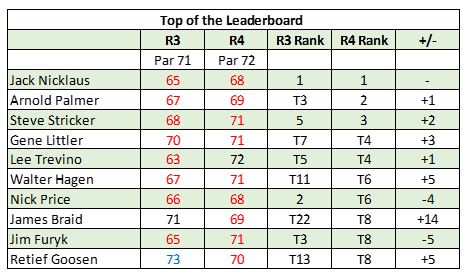
As you can see, James Braid (1910) made the biggest leap into the Top 10, moving up 14 spots from T22 to T8. Here are other big gainers in Round 4:
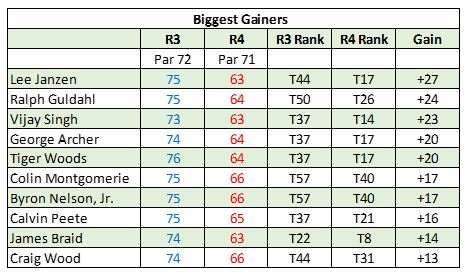
Lee Janzen (1993) rebounded most of all, climbing 27 spots from T44 to T17. The biggest losers moved even more than that but in the wrong direction:
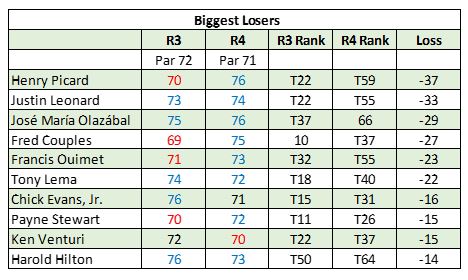
Henry Picard (1939) fell the furthest at 37 spots, slipping all the way to T59 from T22.
Rounds 1 and 2
This tournament began on July 7, 2020 at Yatch Club (Harbour Town) under Blustery, Soft conditions with all 144 of the original ATG golfers. Lee Trevino (1971) led after the first round with an 8-under 63.
The second round took place at Badger Links (Whistling Straits) under Normal, Moderate conditions. Nicklaus rose a notch from a tie for second place to lead Price by a stroke at 10-under. Trevino dropped to third, still at 8-under par.
The cut line following round 2 was 1-over par, leaving only 69 golfers to move on. Among those greats that didn’t make the cut were Ben Hogan (+2), Gary Player (+2), Bobby Jones, Jr. (+3), Mark O’Meara (+4), and Nick Faldo (+5). This just goes to show that anything can happen in APBA Golf, especially when playing with windy conditions (Yatch Club) or on more difficult greens (Badger Links).
Here’s a list of all the ATG golfers who didn’t make the cut:
Rounds 3 and 4
Continuing westward across the U.S., the third round took place at Gopher Lakes (Hazeltine National) under Calm, Normal conditions. Nicklaus and Price solidified their 1 – 2 positions with Jack finishing round 3 at 15-under par and Nick at 12-under. Jim Furyk (2003) and Palmer moved into a tie for fourth place at 10-under.
Los Angeles was chosen for the fourth and final round, partly due to its left coast location but also because of its ease of play. I needed a little reprieve after foraging through all the deep rough at Badger Links and cumbersome course notes at Gopher Lakes.
L.A. did not disappoint! Once again, I had Calm, Normal conditions, but this time no water or OB to contend with and only a few, simple hole notes. (The only way to get a penalty stroke is to hit the ball into the trees and lose it or have an unplayable lie.) These differences were reflected in the scoring. This was the only round where the average score was under par (-2.4 strokes).
In retrospect, I wish I had used the Major Tournament Putting boards instead of the Regular Putting boards for round 4. I estimate that that would have raised the scoring average about two strokes.
Here is a round-by-round tournament summary:
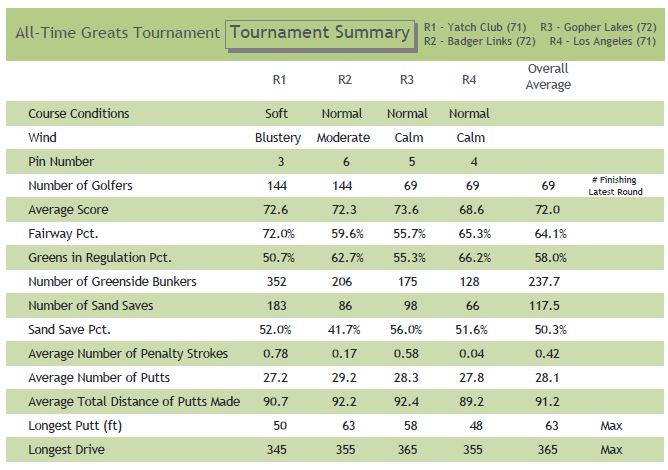
Playing Los Angeles
By far, the easiest hole was #1– a 503-yard par 5. Forty-five (65.2%) of the 69 golfers birdied it, 7 had eagles, and there was even 1 double-eagle. It played -0.88 strokes below par.
The hardest hole, if you can call it that, was #4 — a 236-yard par 3. What made it slightly difficult was the far left pin placement and a large bunker fronting the green. You could easily end up short-sided with no way to target the pin. Even so, this hole only averaged 0.16 strokes above par. Twelve players (17.4%) managed to birdie it, while 23 (33.3%) turned in a bogey.
Here are the par variances for each hole at Los Angeles for round 4:
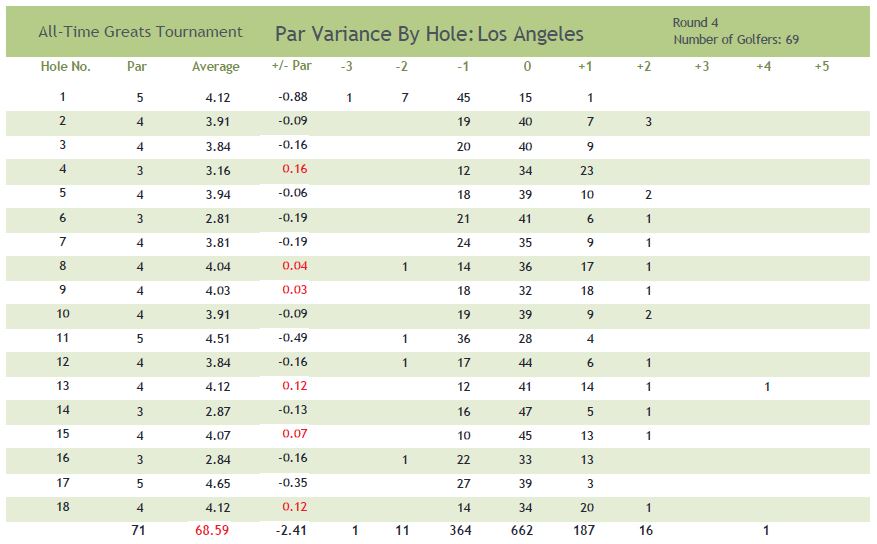
Los Angeles is a great course for newcomers to either APBA Golf or the Game Caddie. There are no water hazards or OB, no complicated hole notes, and no unusual course features. This means there is less to learn starting out and makes it possible to score well even as a rookie APBA player.
The course wind rating is “D.” Therefore, you have Calm conditions most of the time (>61%) and it’s seldom Blustery (<14%), assuming you roll the dice to establish Day Wind conditions. Because there are no hole notes pertaining to wind, you can use the Game Caddie’s Standard Wind mode. That will allow you to play much faster, since the Game Caddie will handle all the wind rolls for you.
My only complaint about Los Angeles is that it can be hard to see where you are going at times (smog?). Most of the holes have a fairly dark green background. As such, there isn’t much contrast between the rough or trees and the black gridlines. Locating your ball marker on par 5’s can be especially difficult, since the gridlines are spaced even more closely together.
One more thing . . . I bought this course years ago in binder format. The version of Los Angeles that APBA currently sells is separate unlaminated sheets like they have been offering for several years now. However, I’m told it is somewhat smaller area-wise than their newer course renderings.
Bottom line: While Los Angeles may be less visually appealing than many other APBA courses, I recommend it because it’s easy and fun to play.
Playing with the ATG Golfers
When I began this tournament, there were only 144 APBA cards in the ATG set. Last year, an additional 36 cards were added. Since my tournament was already in the third round by that point, I did not include the newer carded players in this tournament.
I have not done any statistical comparisons between the ATG players and the regular season players, although the Putting Probability Tools I’ve developed would make that relatively easy (yet time-consuming) to do. Even so, I thought I’d offer a few impressions.
As with the regular season golfers, I do believe putting ability makes a huge difference. I don’t think it’s a coincidence that Nicklaus won my ATG tournament AND also has the best putting numbers overall based on my rating system.
The likelihood of making long putts (41+ feet) seems to be much higher for many (but not all) ATG golfers. If I looked into it, I bet it would be statistically too high. (I would make the same bet for regular season golfers.)
I can say for certain that just because a player is designated as an ATG, that doesn’t mean he’ll always shoot well or even halfway decent. Tom Watson (1977) turned in an incredibly bad round of 86 at Gopher Lakes despite Calm, Normal conditions.
My impression is that the better ATG golfers have more “forgiving” numbers on dice rolls that are usually bad in terms of shot results. This might be said about the very best regular season golfers as well, but it seems to be more true overall for the ATG players. That really shouldn’t be surprising.
I think the thing to keep in mind when playing with the ATG golfers is that on any particular day, there is no guarantee that your scores will be “great.” There can be a lot of variability when it comes to individual performances. In general, though, over many rounds of play you can expect any random subset of ATG golfers to outscore any random subset of regular season golfers.
I am not enough of a golf historian to have an opinion on whether certain players deserve to be included in the ATG card set. All I can tell you is that Henry Cotton (1937) wouldn’t be at the top of my Ryder Cup list based on his APBA card! (He finished dead last in my tournament at 14-over after two rounds.)
The PDF document below contains the full set of statistical results for my ATG Tournament: